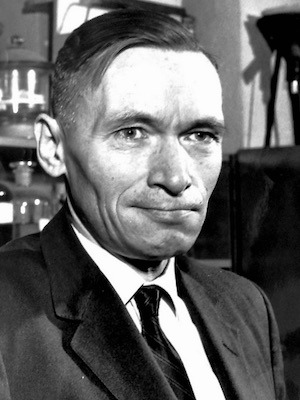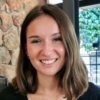Klaus Patau
Klaus Pätau (1908 – 1975) was a German-born, American Cytogeneticist.
Discovered two human Trisomies (trisomy 13 and 18) whilst observing patients with multiple developmental abnormalities. Trisomy 13 is most commonly termed Patau Syndrome.
Patau worked in the Department of Genetics at the University of Wisconsin–Madison, as was his wife and collaborator, the Finnish cytogeneticist Eeva Therman (1916–2004).
Biography
- Born 30 September 1908 in Gelsenkirchen, Germany
- 1936 – PhD, University of Berlin
- 1939 to 1946– Worked at the Kaiser Wilhelm Institute for Biology, Germany
- 1946 – Assistant at the Institute for Genetics at the Berlin University
- 1947 – Institute of Animal Genetics, University of Edinburgh
- 1948 – Emigrated to the United States to work at the University of Wisconsin-Madison
- 1960 – Published a paper describing the extra chromosome in Trisomy 13
- 1961 – Married Finnish-American cytogeneticist Eeva Therman (1916-2004) [known as Mrs. X Chromosome for her extensive research into sex chromosomes]
- Died 30 November 1975 in Madison, Wisconsin
Medical Eponyms
Patau syndrome [Bartholin-Patau syndrome, Trisomy 13] (1960)
- Originally described in 1657 in a case study ‘Monstrum sine oculis‘ by Thomas Bartholin (1616 – 1680)
- First cytogenetic description in 1960 by Klaus Patau and collaborators in a single patient. Initially Trisomy D (13-15) or D1 Trisomy syndrome
Trisomy 13 occurs when there is an extra copy of chromosome 13 resulting in a total of 47 chromosomes instead of 46. The severity of symptoms is affected by whether the patient has a full trisomy or mosaic form, where only some cells in the body are affected. It is thought to occur in around 1 in 16,0000 births, however miscarriage is common in early pregnancy and the overall incidence may therefore be higher.
The first cytogenic description was in a case study of a single patient in 1960, where Patau and his team narrowed down to the chromosomal trisomy to one of 13-15. Another patient was then found to have the same set of congenital abnormalities with the trisomy noted in the same group.
- Patau K, Smith DW, Therman E, Inhorn SL, Wagner HP. Multiple congenital anomaly caused by an extra autosome. Lancet. 1960; 1(7128): 790‐793.
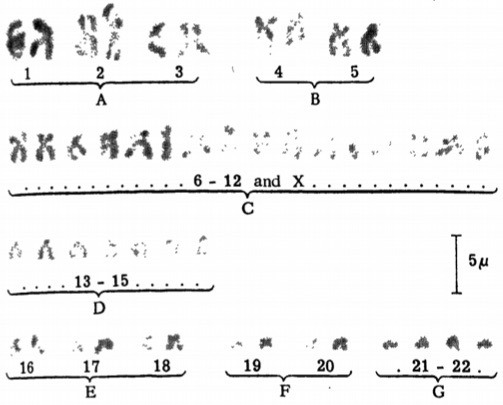
The presence of this extra chromosome is regarded as the cause of the following observed combination of congenital anomalies: Cerebral defect, Apparent anophthalmia, Cleft palate, Hare lip, Simian creases, “Trigger thumbs”, Polydactyly, Capillary haemangiomata, Heart defect
Patau et al, 1960
In 1963 a further paper by Smith et al was published describing further patients with the same clinical syndrome and additional chromosome in the D group. However, they were still not able to differentiate which specific chromosome the trisomy was a result of.
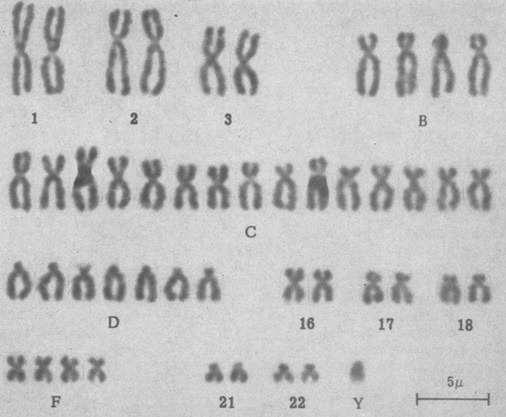
- Smith DW, Patau K, Therman E, Inhorn SL, Demars RI. The D-I trisomy syndrome. J Pediatr. 1963; 62: 326-341.
A case study published in 1976 by Mankinen and Sears reported cytogenic analysis distinguishing Trisomy 13. This was based on the Paris Conference 1971 (Standardization in Human Cytogenetics description).

Most of the cases of D-group trisomy reported were discovered before the advent of G and Q banding, making accurate identification of the additional D group chromosome impossible in most instances
Mankinen and Sears 1976
Edwards syndrome [Trisomy 18]
In a case report of two patients in September 1960 a further trisomy was shown to belong to the “E” group of chromosomes, consisting of the number 16-18. An addendum was later added clarifying the chromosome trisomy as 18 and this was noted to be the same as the case presented as Trisomy 17 by Edwards et al in 1960.
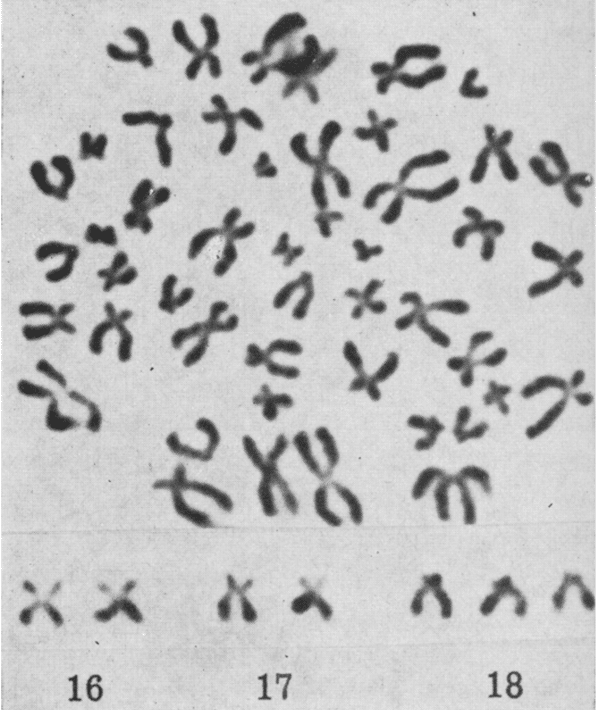
Fig. 3. Top: 47 chromosomes in bone marrow cell of an infant (Case 41) trisomic for chromosome No. 18; original magnification x 2,840. Bottom: the E chromosomes from the same cell; original magnification x 4,030.
- Smith DW, Patau K, Therman E, Inhorn SL. A new autosomal trisomy syndrome: multiple congenital anomalies caused by an extra chromosome. J Pediatr. 1960; 57(3): 338‐345.
Major Publications
- Pätau K. Ein neuer Fall haploider Parthenogenese. Naturwissenschaften, 1934; 22: 648–649
- Pätau K. Chromosomenmorphologie bei Drosophila melanogaster und Drosophila simulans und ihre genetische Bedeutung. Naturwissenschaften, 1935; 23: 537–543.
- Pätau K. Die mathematische Analyse der Evolutionsvorgänge. Zeitschrift für Induktive Abstammungs- und Vererbungslehre, 1939; 76: 220–228
- Patau K, Smith DW, Therman E, Inhorn SL, Wagner HP. Multiple congenital anomaly caused by an extra autosome. Lancet. 1960; 1(7128): 790‐793.
- Smith DW, Patau K, Therman E, Inhorn SL. A new autosomal trisomy syndrome: multiple congenital anomalies caused by an extra chromosome. J Pediatr. 1960; 57(3): 338‐345.
- Smith DW, Patau K, Therman E. Autosomal trisomy syndrome. Lancet, 1961; 278(7195): 211–212
- Smith DW, Patau K, Therman E, Inhorn SL, Demars RI. The D-I trisomy syndrome. J Pediatr. 1963; 62: 326-341.
- Patau K. The origin of chromosomal abnormalities. Pathol Biol. 1963; 11: 1163-1170.
- Therman E, Pätau K. Abnormal X chromosomes in man: Origin, behavior and effects. Hum Genet, 1974; 25: 1–16
Controversies
- Original given name: Klaus Pätau
References
Biography
- Bibliography. Klaus Pätau. World Cat Identities
- Portrait: Klaus Patau (1908-1975), Department of Genetics, University of Wisconsin-Madison
Syndrome
- Tjio JH, Levan A. The Chromosome Number of Man. Hereditas 1956; 42: 1-6 [First description of the number of chromosomes as 46]
- Warburg M. Anophthlmos complicated by mental retardation and cleft palate. Acta Ophthalmol (Copenh). 1960; 38: 394‐404. [First link to Bartholin original description of trisomy 13]
- Warburg M, Mikkelson M. A case of 13-15 trisomy or Bartholin-Patau’s syndrome. With a review of the ophthalmological literature concerning cases with similar symptomatology. Acta ophthal. (Kbh.), 1963; 41: 321-334. [First use of term Bartholin-Patau syndrome]
- Snodgrass GJ, Butler LJ, France NE, Crome L, Russell A. The “D” (13-15) trisomy syndrome: an analysis of 7 examples. Arch Dis Child. 1966; 41(217): 250‐261.
- Paris Conference (1971): Standardization in human cytogenetics. Cytogenetics. 1972;11(5):317-362.
- Mankinen CB, Sears JW. Trisomy 13 in a female over 5 years of age. J Med Genet. 1976;13(2):157-161

